Sony VAIO Pro 13: Exceptionally Portable
by Jarred Walton on October 16, 2013 12:00 AM ESTSony VAIO Pro 13: Performance
In most areas, the performance of the VAIO Pro 13 is more than sufficient. Loading up Windows and common applications, surfing the web, and even video encoding (especially with an application that supports Quick Sync) are all plenty fast. There are faster laptops out there, certainly, but they don't have anywhere near this level of portability. Here's our standard selection of performance metrics, and you can see that the VAIO Pro 13 is basically in line with other Ultrabooks. Note that most of the other Ultrabooks have used Core i7 ULV processors, so here the VAIO Pro 13 is at a disadvantage. The cores specs for the tested laptops are listed in the table below, and additional benchmark results are available in Mobile Bench.
| Overview of Laptops in Charts | ||||||
| Laptop | CPU | GPU | Storage | RAM | LCD | Battery |
| Acer R7-571-6858 | Intel Core i5-3317U | HD 4000 | 500GB HDD + 24GB SSD | 1x4GB + 1x2GB | 15.6” 1080p Glossy AHVA Touchscreen | 4-cell 54Wh |
| Acer S7-391-9886 | Intel Core i7-3517U | HD 4000 | 2x128GB RAID 0 SSDs | 2x2GB | 13.3” 1080p Glossy AHVA Touchscreen | 4-cell 35Wh |
| Acer V7-482PG-9884 | Intel Core i7-4500U | GT750M DDR3 / HD 4400 | 1TB HDD + 24GB SSD | 1x4GB + 1x8GB | 14” 1080p Glossy AHVA Touchscreen | 4-cell 54Wh |
| AMD Kabini Prototype | AMD A4-5000 | HD 8330 | 256GB SSD | 1x4GB | 14” 1080p Matte IPS | 6-cell 45Wh |
| Apple MacBook Air 13 (2013) | Intel Core i5-4250U | HD 5000 | 128GB PCIe SSD | 2x2GB | 13.3” 1440x900 Glossy TN | 4-cell 54Wh |
| Dell XPS 12 | Intel Core i7-3517U | HD 4000 | 256GB SSD | 2x4GB | 13.3” 1080p Glossy IPS Touchscreen | 4-cell 47Wh |
| Dell XPS 13 | Intel Core i5-3337U | HD 4000 | 256GB SSD | 2x4GB | 13.3” 1080p Glossy IPS | 6-cell 47Wh |
| Sony VAIO Pro 13 | Intel Core i5-4200U | HD 4400 | 128GB PCIe SSD | 2x2GB | 13.3” 1080p Glossy IPS Touchscreen | 3-cell 37Wh |
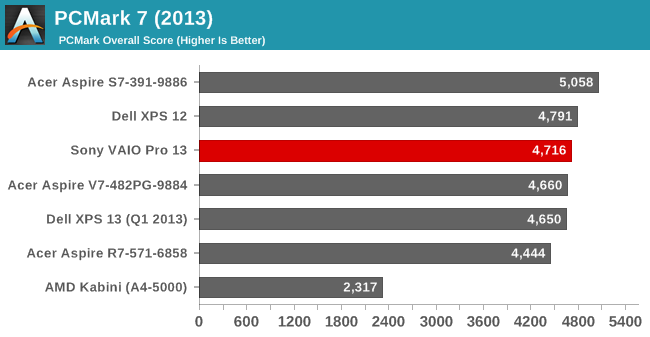
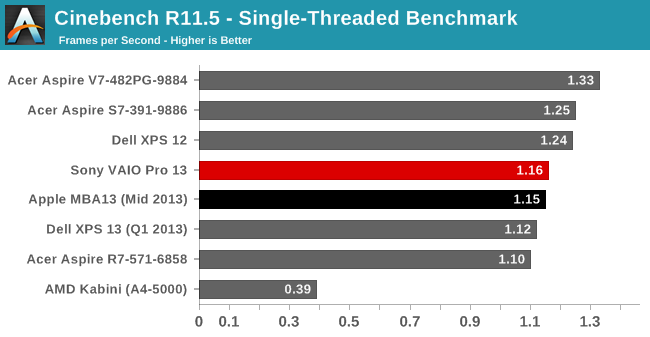
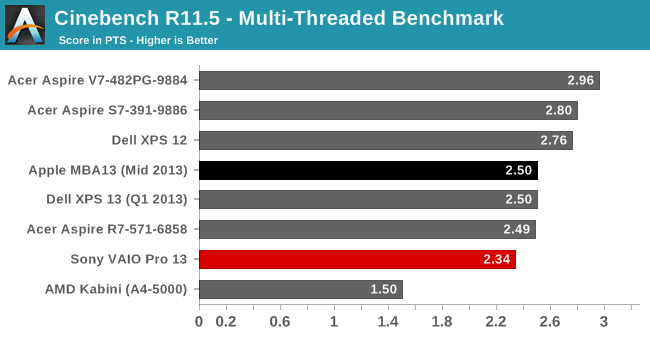
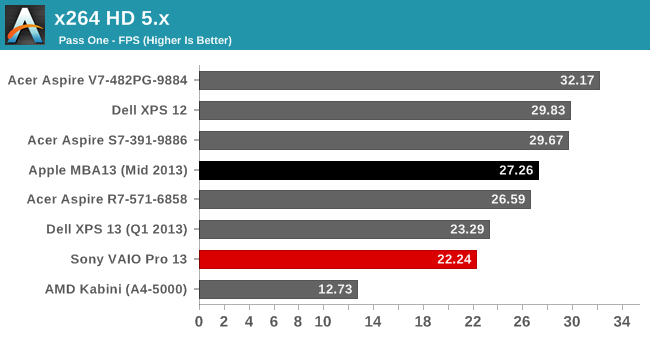
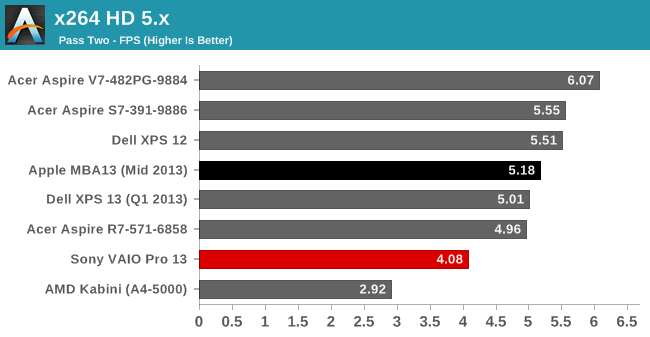
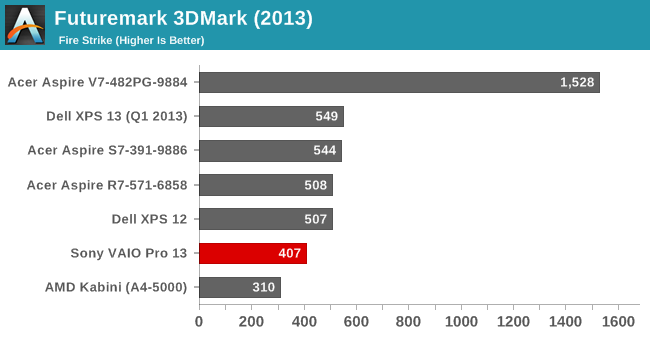
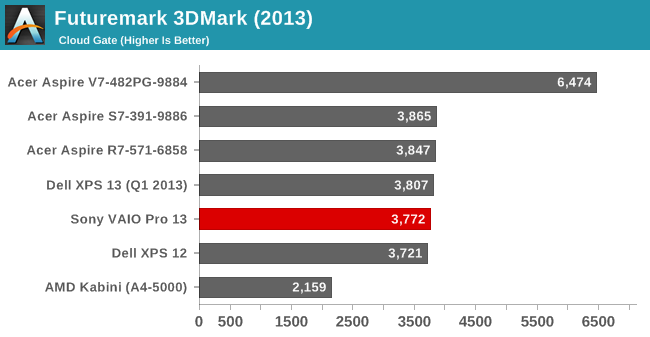
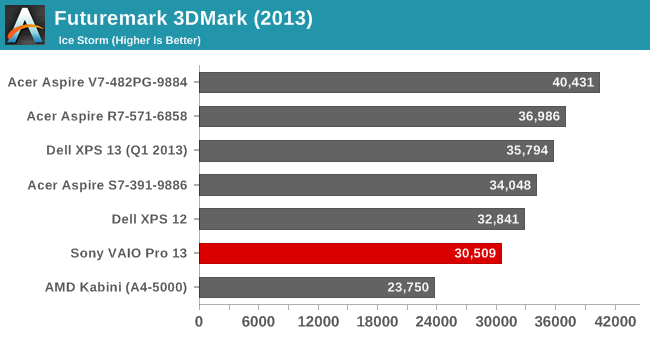
In our general performance graphs, here we get another results showing that Haswell isn't really any faster than Ivy Bridge in most tests (unless it has a GT3/GT3e iGPU, or in specific tests that leverage the new instructions). Move to the 3DMark results and the VAIO Pro 13 doesn't really look so hot. It's now clearly slower than the Core i7 Ivy Bridge Ultrabooks, which isn't something I'd expect from 20 EUs. Either Intel actually has slower EUs in Haswell than in Ivy Bridge, or Sony is curbing performance of the iGPU to keep within their desired thermal range. Our gaming results continue this trend:
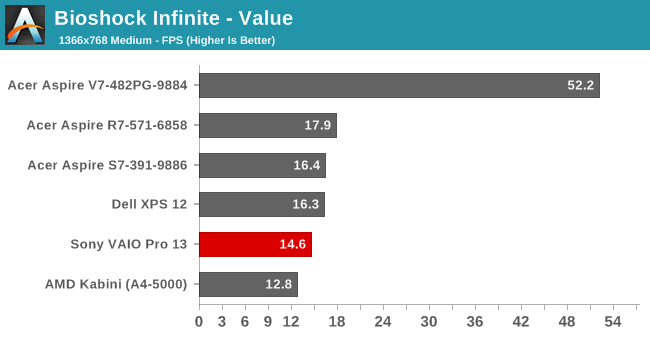

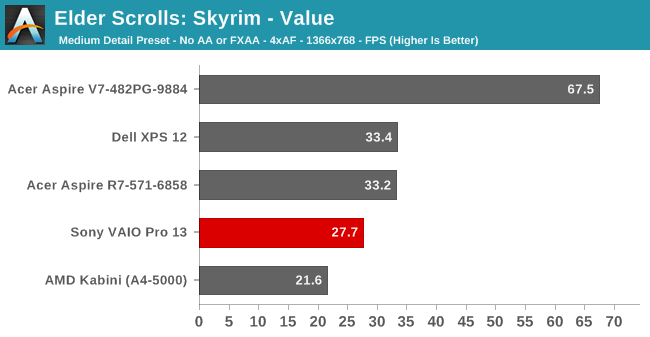
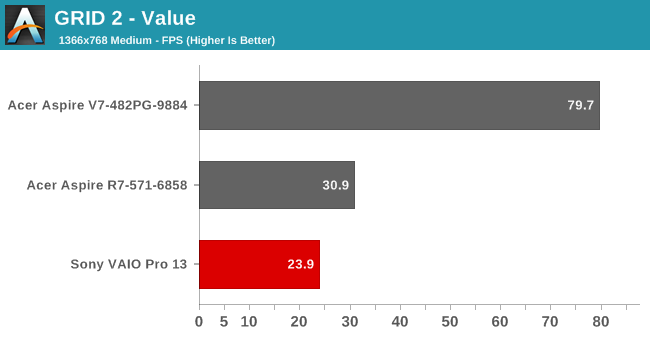
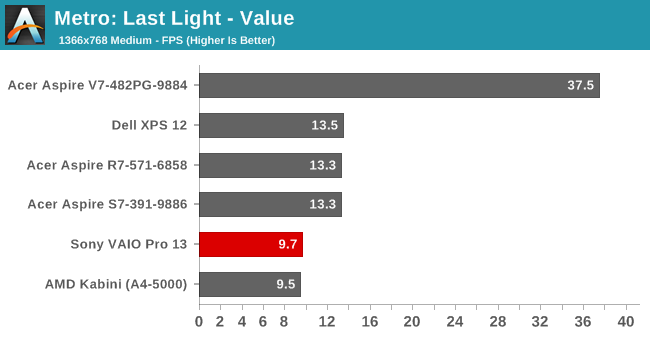
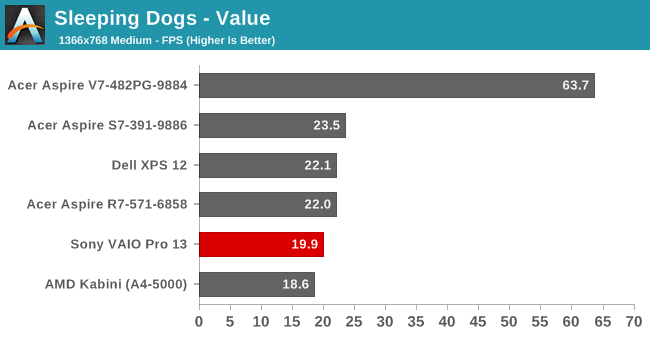
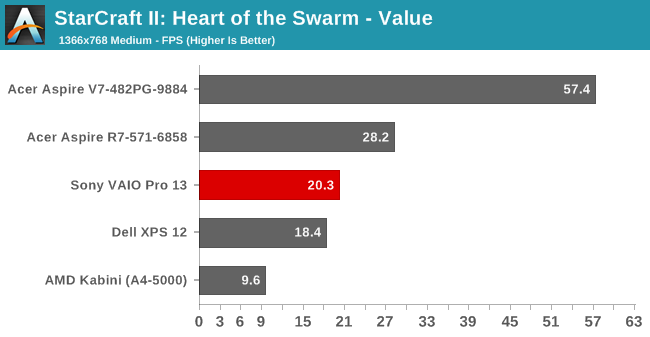
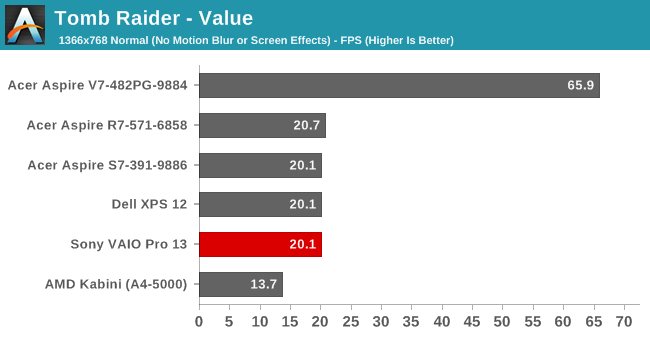
Other than in StarCraft II: Heart of the Swarm and Tomb Raider, the VAIO Pro 13 ends up being slower than every other Intel Ultrabook that we've tested. The Acer V7 isn't technically an Ultrabook, though it's close enough in many respects, but we can see just how much even a moderate dGPU adds in terms of performance. We also have some results for Crystalwell (i7-4750HQ) in Mobile Bench that we're not including here, and GT3e is much faster as well (though the Clevo W740SU doesn't do all that well in the battery life department). Perhaps GT3 would help the VAIO Pro 13, but several games seemed to have issues maintaining higher iGPU clocks – Metro for instance showed cyclic higher/lower performance during the benchmark runs. It's mostly a moot point, though, as outside of light gaming the HD 4400 simply isn't fast enough to handle a lot of games.










106 Comments
View All Comments
JarredWalton - Wednesday, October 16, 2013 - link
The sheet battery raises the back about half an inch (1.34" total height at rear -- 34.1mm) and according to my little food scale the laptop with the battery weighs 2.97 pounds (1.348kg).Amkitsaw - Wednesday, October 16, 2013 - link
Thanks so much! It's a great review; I completely agree with your assessment at the end about manufacturers raising the ~$1200 ultrabook spec to 8GB/256GB. It's a little ridiculous so many manufacturers are holding onto 4GB in 2013.teiglin - Wednesday, October 16, 2013 - link
Nice review as always, Jarred. One issue though--my Vaio Pro 13 claims to have Dual-Band Wireless-N 7260 (<3 Intel part naming) and has no apparent issues connecting to my 5GHz AP. Is it possible that this varies between models?The one other downside of the flex-y chassis you don't mention (maybe didn't encounter?) is that you can actually click the clickpad by pressing down on either side of the touchpad, or by placing a thumb between the touchpad and the edge, and lifting the laptop with your hand underneath it. Practically this is only very rarely an issue (if I'm walking around and holding the laptop by the front, mostly--and the lightness makes this something I do more often than I would have thought), but it bears mentioning.
On the pricing front, I would love to see Sony come down a bit, but it's been four months and there is still pretty sparse competition. There's the Acer S7--on Amazon, $1300 for the i5/128GB SSD/8GB RAM model, or $1580 for i7/256GB SSD upgrade--or the ATIV Book 9 for $1400, but in order to get its beautiful screen, you have to suffer its ridiculous single configuration of 128GB SSD/4GB RAM. Dell's XPS 13 is still Ivy if you buy it today, and the XPS 12 is neither priced much better (especially with upgrades), nor to my mind a directly competing product. Especially now that you can shave $100 off by dropping the touchscreen, Sony's still at or near the front of the Haswell ultrabook pack in value here. It'll be interesting to see how the rMBP 13 compares--and the Zenbook Infinity, if it ever materializes.
teiglin - Wednesday, October 16, 2013 - link
Forgot to mention the Surface Pro 2, since you did--if you're comparing to that, you should probably compare the 11" flavor, which starts at $100 less than the 13 and essentially costs the same as Surface Pro 2 when you include a type cover. I do think for roughly the same price, Surface Pro wins that value comparison easily, though again if the tablet-y-ness isn't a factor you save $100 by dumping the touchscreen in the VAIO.Also on that topic, you wrote that Surface Pro 2 comes out in "ten weeks"--doesn't it come out next week? The Anandtech article (admittedly old at this point) says Oct 22.
JarredWalton - Wednesday, October 16, 2013 - link
Should have said 10 days. Heh. Wrote that earlier so now I need to edit it....7heF - Wednesday, October 16, 2013 - link
There is A LOT of Vaio Pro 13 owners that has huge wifi-problems. If you are in the same room as the AP, it can be ok, but some distance a a couple of walls and this pc is one of the worst on the market. No antenna in the screen - just a small cable behind the motherboard.I use a usb-dongle for wifi. With the internal solution, some of my 802.11g-based old pc's have much better range. My house ain't that large, but all over the house I can get coverage on the iPhone and the iPad - but with the Sony the performance is very low, unstable or completly without a connection.
Sony have for months said there will be an software update for this problem. I doubt it. I belive the antenna is the problem and that it really can't be fixed.
There is a huge thread at the Sony forums about the issue: http://community.sony.com/t5/VAIO-Hardware-Network...
JarredWalton - Wednesday, October 16, 2013 - link
Text on pages 2 and 6 has been updated. It's odd that the WiFi works so well within my home, but the exterior walls just kill throughput (assuming you can connect at all). I had some similar issues with the Acer R7, though oddly only on the 2.4GHz band.whatever61 - Wednesday, October 16, 2013 - link
You don't mention an important factor, that this laptop has a problematic wifi.There's no solution for months and probably the problem is in the hardware.
To be more specific, the speed drops drastically when the signal is not good. Some say it's because of a bad antenna location. Anyway, it's a very strong factor to take into account before buying this awesome (besides that one flaw) laptop.
Also, take into account that the back cover is very easily scratchable (way too easy!)
And yes, the extremely light weight is really exceptional!
JarredWalton - Wednesday, October 16, 2013 - link
As noted above, the text on pages 2 and 6 has been updated. Thanks!juhatus - Wednesday, October 16, 2013 - link
I bought the Vaio Pro 13 (i7-4500, 8Gb, 256gb toshiba ssd, no touch, 3year warranty) almost 2 months ago for 1200€. I must admit that it had it driver problems on start but every update has actually made a difference and now all problems are solved. It had a bit problems with fan, bluetooth and wifi, but as i said, updates solved those.I have to totally disagree with the "built quality"-issue, flexibility is by design not because they used sub-par engineering and materials. If you check how big the actual motherboard is, its about half of the depth of the laptop so its not flexing at all. One reviewer also noted that Sony has done these flexible design's before and now few years after those laptops haven't gotten any problems. If you close the lid than vaio 13 isnt bending almost at all. Jarred if you need a crowbar, than use something else than laptop :)
Jarred could you add some benchmarks about the ssd speed? If you get the samsung model.. its should do almost 1Gb/sec sequantials and the 4k read/writes arent that bad either. I got the 256gb toshiba and it still beats a samsung 840pro.
One thing about the display and calibration, Pro13 should use Sony's Tri-luminos tech and that surely could confuse the colormeter?